新编日雅思阅读真题与解析
- 格式:docx
- 大小:56.44 KB
- 文档页数:6
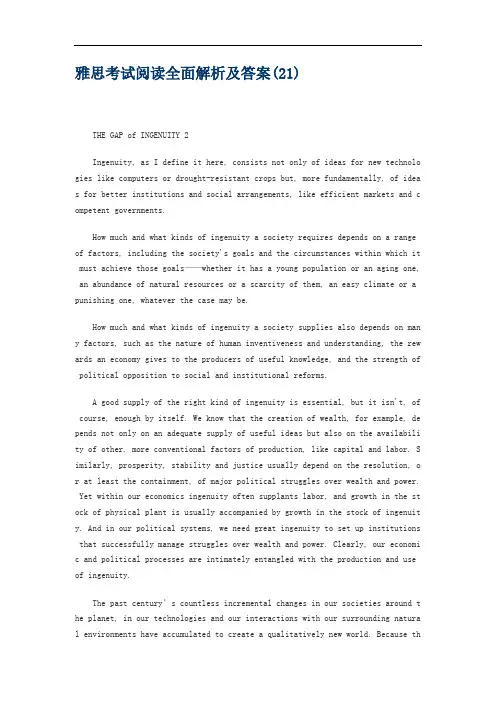
雅思考试阅读全面解析及答案(21)THE GAP of INGENUITY 2Ingenuity, as I define it here, consists not only of ideas for new technolo gies like computers or drought-resistant crops but, more fundamentally, of idea s for better institutions and social arrangements, like efficient markets and c ompetent governments.How much and what kinds of ingenuity a society requires depends on a range of factors, including the society's goals and the circumstances within which it must achieve those goals——whether it has a young population or an aging one, an abundance of natural resources or a scarcity of them, an easy climate or a punishing one, whatever the case may be.How much and what kinds of ingenuity a society supplies also depends on man y factors, such as the nature of human inventiveness and understanding, the rew ards an economy gives to the producers of useful knowledge, and the strength of political opposition to social and institutional reforms.A good supply of the right kind of ingenuity is essential, but it isn't, of course, enough by itself. We know that the creation of wealth, for example, de pends not only on an adequate supply of useful ideas but also on the availabili ty of other, more conventional factors of production, like capital and labor. S imilarly, prosperity, stability and justice usually depend on the resolution, o r at least the containment, of major political struggles over wealth and power. Yet within our economics ingenuity often supplants labor, and growth in the st ock of physical plant is usually accompanied by growth in the stock of ingenuit y. And in our political systems, we need great ingenuity to set up institutions that successfully manage struggles over wealth and power. Clearly, our economi c and political processes are intimately entangled with the production and use of ingenuity.The past century’s countless incremental changes in our societies around t he planet, in our technologies and our interactions with our surrounding natura l environments have accumulated to create a qualitatively new world. Because these changes have accumulated slowly, It’s often hard for us to recognize how p rofound and sweeping they've. They include far larger and denser populations; m uch higher per capita consumption of natural resources; and far better and more widely available technologies for the movement of people, materials, and espec ially information.In combination, these changes have sharply increased the density, intensity, and pace of our inter actions with each other; they have greatly increased the burden we place on our natural environment; and they have helped shift power f rom national and international institutions to individuals and subgroups, such as political special interests and ethnic factions.As a result, people in all walks of life-from our political and business le aders to all of us in our day-to-day——must cope with much more complex, urgen t, and often unpredictable circumstances. The management of our relationship wi th this new world requires immense and ever-increasing amounts of social and te chnical ingenuity. As we strive to maintain or increase our prosperity and impr ove the quality of our lives, we must make far more sophisticated decisions, an d in less time, than ever before.When we enhance the performance of any system, from our cars to the planet' s network of financial institutions, we tend to make it more complex. Many of t he natural systems critical to our well-being, like the global climate and the oceans, are extraordinarily complex to begin with. We often can't predict or ma nage the behavior of complex systems with much precision, because they are ofte n very sensitive to the smallest of changes and perturbations, and their behavi or can flip from one mode to another suddenly and dramatically. In general, as the human-made and natural systems we depend upon become more complex, and as o ur demands on them increase, the institutions and technologies we use to manage them must become more complex too, which further boosts our need for ingenuit y.The good news, though, is that the last century's stunning changes in our s ocieties and technologies have not just increased our need for ingenuity; they have also produced a huge increase in its supply. The growth and urbanization o f human populations have combined with astonishing new communication and transp ortation technologies to expand interactions among people and produce larger, more integrated, and more efficient markets. These changes have, in turn, vastly accelerated the generation and delivery of useful ideas.But—and this is the critical "but"——we should not jump to the conclusion that the supply of ingenuity always increases in lockstep with our ingenuity r equirement: While it's true that necessity is often the mother of invention, we can't always rely on the right kind of ingenuity appearing when and where we n eed it. In many cases, the complexity and speed of operation of today's vital e conomic, social, arid ecological systems exceed the human brains grasp. Very fe w of us have more than a rudimentary understanding of how these systems work. T hey remain fraught with countless "unknown unknowns," which makes it hard to su pply the ingenuity we need to solve problems associated with these systems.In this book, explore a wide range of other factors that will limit our abi lity to supply the ingenuity required in the coming century. For example, many people believe that new communication technologies strengthen democracy and wil l make it easier to find solutions to our societies' collective problems, but t he story is less clear than it seems. The crush of information in our everyday lives is shortening our attention span, limiting the time we have to reflect on critical matters of public policy, and making policy arguments more superficia l.Modern markets and science are an important part of the story of how we sup ply ingenuity. Markets are critically important, because they give entrepreneur s an incentive to produce knowledge. As for science, although it seems to face no theoretical limits, at least in the foreseeable future, practical constraint s often slow its progress. The cost of scientific research tends to increase as it delves deeper into nature. And science's rate of advance depends on the cha racteristic of the natural phenomena it investigates, simply because some pheno mena are intrinsically harder to understand than others, so the production of u seful new knowledge in these areas can be very slow. Consequently, there is oft en a critical time lag between the recognition between a problem and the delive ry of sufficient ingenuity, in the form of technologies, to solve that problem. Progress in the social sciences is especially slow, for reasons we don't yet u nderstand; but we desperately need better social scientific knowledge to build the sophisticated institutions today’s world demands.Questions:Complete each sentence with the appropriate answer, A, B, C, or DWrite the correct answer in boxes 27-30 on your answer sheet.27 The definition of ingenuity28 The requirement for ingenuity29 The creation of social wealth30 The stability of societyA depends on many factors including climate.B depends on the management and solution of disputes.C is not only of technological advance, but more of institutional renovatio n.D also depends on the availability of some traditional resources.Question 31-33Choose the correct letter, A, B, C, or D.Write your answers in boxes 31-33 on your answer sheet.31 What does the author say about the incremental change of the last 100 ye ars?A It has become a hot scholastic discussion among environmentalists.B Its significance is often not noticed.C It has reshaped the natural environments we live in.D It benefited a much larger population than ever.32 The combination of changes has made life.A easierB fasterC slowerD less sophisticated33 What does the author say about the natural systems?A New technologies are being developed to predict change with precision.B Natural systems are often more sophisticated than other systems.C Minor alterations may cause natural systems to change dramatically.D Technological developments have rendered human being more independent of natural systems.Question 34-40Do the following statements agree with the information given in Reading Pas sage 3?In boxes 34-40 on your answer sheet, writeYES if the statement is trueNO if the statement is falseNOT GIVEN if the information is not given in the passage34 The demand for ingenuity has been growing during the past 100 years.35 The ingenuity we have may be inappropriate for solving problems at hand.36 There are very few who can understand the complex systems of the present world.37 More information will help us to make better decisions.38 The next generation will blame the current government for their conduct.39 Science tends to develop faster in certain areas than others.40 Social science develops especially slowly because it is not as important as natural science.参考译文:创新过程的空白创造,就像笔者在这里定义的一样,不仅仅指那些关于计算机、抗早作物之类的新科技的构想,更重要的是指那些关于优化制度和社会安排的思想,例如高效市场、法定政府等。
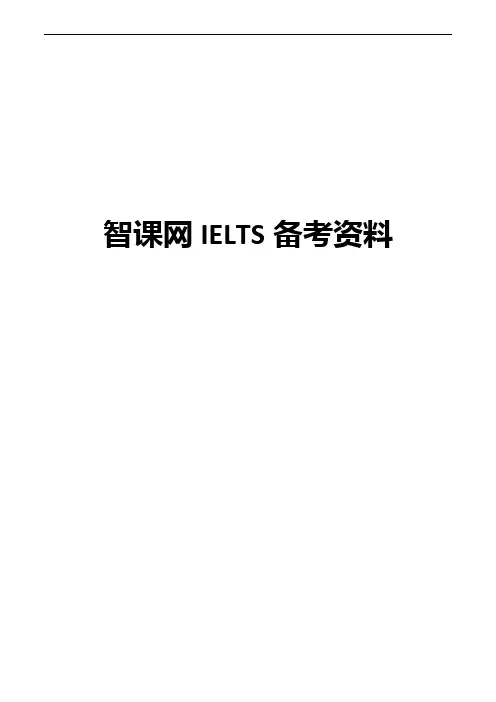
智课网IELTS备考资料雅思阅读真题附答案及解析摘要:雅思阅读真题附答案及解析,雅思阅读真题附答案及解析是小编整理汇总的最新的雅思阅读真题,在如此紧张的备考环节,大家就应该多看看雅思阅读真题,会大大提高你的效率,更多精彩内容请关注小马科技雅思频道官网。
Passage 1主题:科技类 (新题)题目:英国的酒精燃料题型:填空,判断文章大意:乙醇作为新燃料的提炼过程和与汽油的对比参考答案:1-5 判断题1.因果农民不太可能会为了制造乙醇燃料大种甘蔗 (True)2.在的农名讲扩大生产更多乙醇植物 (True)3.A gallon ethanol have more engineer than a gallon gasoline. (NG)4.在将来美国将会有充足的crop在制造氢气。
(false)5.乙醇的生产者会尽量减少生产过程中使用的能量。
(NG)6-10 填空题distillerligninremainsbioreactorfiber备考建议:科技类文章不太好理解,而且生词会比较多。
建议大家在考前可以多多积累相关题材的词汇。
参考阅读:C542Passage 2题材:历史考古类 (旧题)题目:costal archaeology of Britain题型:单选,判断,多选参考答案:单选:B,C, D判断题:True, False, True, False, NG, True, True多选:BDF备考建议:历史类文章不难理解,且这篇文章的题型都是顺序题型,为我们做题大大降低了难度。
参考阅读:C7T1P1 Let’s go, batsPassage 3:题材:语言类题目:The Origin of Language文章大意:语言的起源,语言与音乐的关系参考阅读:C931 Attitudes to Language以上就是小马过河雅思频道小编为大家汇总的雅思阅读真题附答案及解析,希望同学们能静下心来准备下一轮的考试,加油!成功是属于你们的。
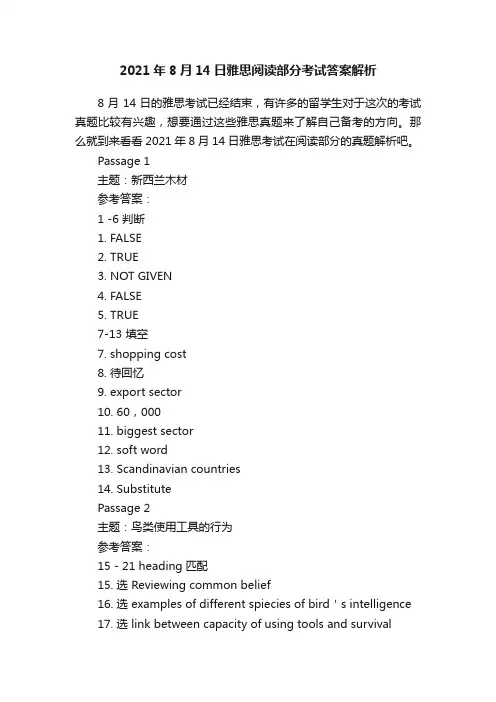
2021年8月14日雅思阅读部分考试答案解析8月14日的雅思考试已经结束,有许多的留学生对于这次的考试真题比较有兴趣,想要通过这些雅思真题来了解自己备考的方向。
那么就到来看看2021年8月14日雅思考试在阅读部分的真题解析吧。
Passage 1主题:新西兰木材参考答案:1 -6 判断1. FALSE2. TRUE3. NOT GIVEN4. FALSE5. TRUE7-13 填空7. shopping cost8. 待回忆9. export sector10. 60,00011. biggest sector12. soft word13. Scandinavian countries14. SubstitutePassage 2主题:鸟类使用工具的行为参考答案:15 - 21 heading匹配15. 选 Reviewing common belief16. 选 examples of different spiecies of bird's intelligence17. 选 link between capacity of using tools and survival18. 选 Physiological evidence of bird's intellgence19. 选link between cognitive ability and society communal performance20. 选 white-winged chough21. 选 how younger birds trick on others22 -27 匹配22. 选 New Caledonian Crows23. 选 Black Kite24. 选 Black Kite25. 选 White-winged Chough26. 选 White-winged Chough27. 选 New Caledonian Crows1.快速浏览全文考生最好用1—2分钟大致浏览全文,以便掌握文章的结构。
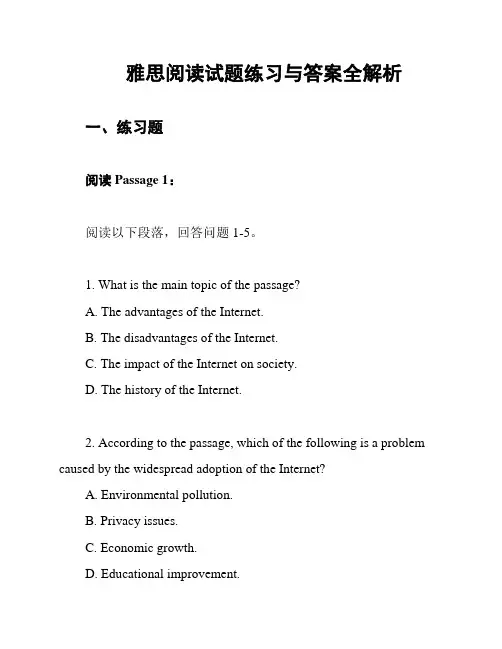
雅思阅读试题练习与答案全解析一、练习题阅读Passage 1:阅读以下段落,回答问题1-5。
1. What is the main topic of the passage?A. The advantages of the Internet.B. The disadvantages of the Internet.C. The impact of the Internet on society.D. The history of the Internet.2. According to the passage, which of the following is a problem caused by the widespread adoption of the Internet?A. Environmental pollution.B. Privacy issues.C. Economic growth.D. Educational improvement.3. Why does the Internet lead to social isolation?A.因为它改变了人们的交流方式B.因为它使人们更容易获取信息C.因为它促进了全球连接D.因为它提供了更多的娱乐方式4. Which of the following is NOT mentioned in the passage?A. Privacy issues.B. The spread of misinformation.C. Social isolation.D. Education inequality.5. In the author's opinion, how should people use the Internet responsibly?A. They should limit their online activities to protect their privacy.B. They should only consume information from trusted sources.C. They should spend more time on social media to stay connected.D. They should use the Internet as an educational tool to enhance their knowledge.阅读Passage 2:阅读以下段落,回答问题6-10。
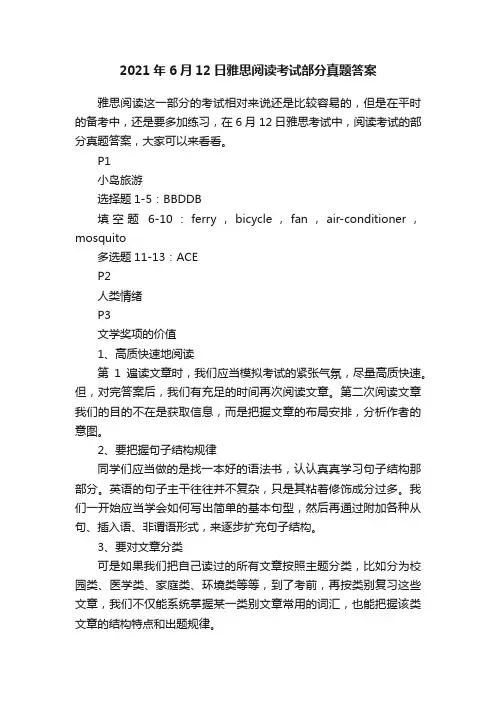
2021年6月12日雅思阅读考试部分真题答案雅思阅读这一部分的考试相对来说还是比较容易的,但是在平时的备考中,还是要多加练习,在6月12日雅思考试中,阅读考试的部分真题答案,大家可以来看看。
P1小岛旅游选择题1-5:BBDDB填空题6-10:ferry,bicycle,fan,air-conditioner,mosquito多选题11-13:ACEP2人类情绪P3文学奖项的价值1、高质快速地阅读第1遍读文章时,我们应当模拟考试的紧张气氛,尽量高质快速。
但,对完答案后,我们有充足的时间再次阅读文章。
第二次阅读文章我们的目的不在是获取信息,而是把握文章的布局安排,分析作者的意图。
2、要把握句子结构规律同学们应当做的是找一本好的语法书,认认真真学习句子结构那部分。
英语的句子主干往往并不复杂,只是其粘着修饰成分过多。
我们一开始应当学会如何写出简单的基本句型,然后再通过附加各种从句、插入语、非谓语形式,来逐步扩充句子结构。
3、要对文章分类可是如果我们把自己读过的所有文章按照主题分类,比如分为校园类、医学类、家庭类、环境类等等,到了考前,再按类别复习这些文章,我们不仅能系统掌握某一类别文章常用的词汇,也能把握该类文章的结构特点和出题规律。
1.注意身体,多喝水,吃些水果。
考前身体千万不要出问题,尤其是感冒之类的,不仅头疼,头沉沉的,心情不好,神志不清,更可怕的是听力还会受此影响。
在考前还要养成一个生物钟比较好。
按照考试顺序和考试时间来要求自己。
早上8点左右可以开始练习,先做听力,然后是阅读,之后是写作,下午可以练习口语,严格把握时间。
这样的顺序都收悉之后,想必考试的时候就信手拈来了。
2.准备证件。
考试要求烤鸭们携带身份证件,照片和准考证按时到考场。
照片需要按照考试要求,自己提前准备好。
准考证提前一天打印即可。
而考试工具就不用担心了,雅思考试时,笔和橡皮是已经准备好的,无需烤鸭担心。
3.踩点儿看考场。
根据不同的考试地点,烤鸭们需要自己去考点看看,熟悉乘车路线,把握乘车时间,提前出门,更不能因为堵车而耽误考试。
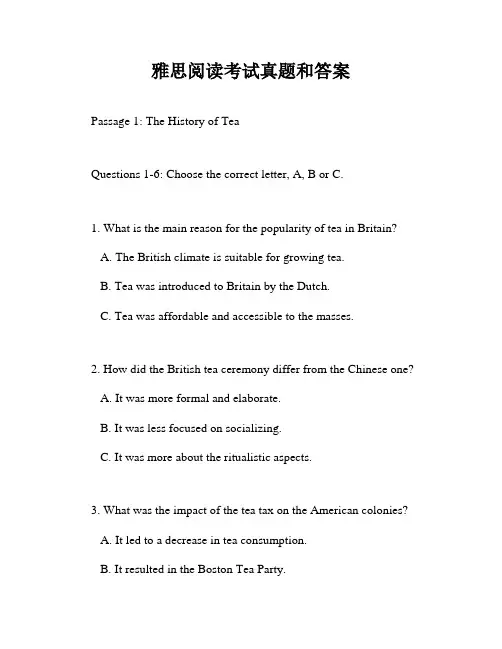
雅思阅读考试真题和答案Passage 1: The History of TeaQuestions 1-6: Choose the correct letter, A, B or C.1. What is the main reason for the popularity of tea in Britain?A. The British climate is suitable for growing tea.B. Tea was introduced to Britain by the Dutch.C. Tea was affordable and accessible to the masses.2. How did the British tea ceremony differ from the Chinese one?A. It was more formal and elaborate.B. It was less focused on socializing.C. It was more about the ritualistic aspects.3. What was the impact of the tea tax on the American colonies?A. It led to a decrease in tea consumption.B. It resulted in the Boston Tea Party.C. It caused the colonies to grow their own tea.4. What is the primary purpose of the tea estates in India?A. To produce tea for export to Europe.B. To provide employment for local workers.C. To preserve traditional tea-making methods.5. What does the author suggest about the future of tea?A. It will become less popular due to health concerns.B. It will continue to be a staple in many cultures.C. It will be replaced by other beverages.6. What is the main focus of the International Tea Day?A. Promoting tea as a healthy beverage.B. Encouraging fair trade practices in the tea industry.C. Celebrating the cultural significance of tea.Answers:1. C2. B3. B4. A5. B6. CQuestions 7-13: Answer the statements with TRUE, FALSE, or NOT GIVEN.7. The British East India Company had a monopoly on tea trade in the 18th century.TRUE8. Tea was initially considered a luxury item in Britain.TRUE9. The Chinese tea ceremony is known for its simplicity.FALSE10. The Boston Tea Party was a protest against high tea prices.FALSE11. The tea estates in India were established to meet domestic demand.FALSE12. The author believes that tea's popularity is declining in modern times.NOT GIVEN13. International Tea Day is celebrated to promote the economic benefits of tea.NOT GIVENPassage 2: The Impact of Social Media on Mental HealthQuestions 14-20: Complete the summary with the correct information from the passage.The Impact of Social Media on Mental HealthSocial media has become an integral part of modern life, with millions of people using platforms such as Facebook, Instagram, and Twitter on a daily basis. However, the effects of social media on mental health have been a topic of concern. Recent studies have shown that there is a correlation between social media use and mental health issues such as anxiety, depression, and low self-esteem.14. A study conducted by the Royal Society for Public Health found that social media can have both positive and negative effects on young people's mental health. The platforms that had the most negative impact were Instagram, Snapchat, and Facebook.15. The comparison of social media use to a "digital mirror" highlights the tendency of users to compare their lives with others, leading to feelings of inadequacy and羡慕.16. The term "FOMO" (Fear of Missing Out) is used to describe the anxiety that arises from seeing others' experiences and achievements on social media, which can exacerbate feelings of isolation and loneliness.17. Some individuals may develop a dependency on social media for validation and self-worth, which can lead to a cycle of seeking approval and reinforcement from online interactions.18. The negative effects of social media can be mitigated by setting boundaries, such as limiting the time spent on social media platforms and being mindful of the content that is consumed.19. It is suggested that parents and educators play a crucial role in guiding young people on how to use social media responsibly and in promoting a healthy relationship with these platforms.20. The potential benefits of social media, such as staying connected with friends and family, sharing experiences, and accessing information, should not be overlooked, as they can contribute positively to mental health when used in moderation.Passage 3: Renewable Energy SourcesQuestions 21-26: Choose the correct letter, A, B or C.21. What is the primary advantage of solar energy according to the passage?A. It is a clean and renewable source of energy.B. It requires minimal maintenance.C. It can be used in remote areas without infrastructure.22. Which of the following is a disadvantage of wind energy?A. It is dependent on weather conditions.B. It has a high initial cost.C. It is harmful to wildlife.23. What is the main concern regarding the use of biofuels?A. They contribute to deforestation.B. They are not as efficient as fossil fuels.C. They can lead to food shortages.24. What is the potential of tidal energy as mentioned in the passage?A. It is a consistent and predictable source of energy.B. It has a low environmental impact.C. It can be used to generate electricity on a large scale.25. What is the current limitation of geothermal energy?A. It is only available in certain geographical locations.B. It requires advanced technology for extraction.C. It is not cost-effective compared to other renewable sources.26. What does the author suggest about the future of renewable energy?A. It will replace fossil fuels completely.B. It will play a significant role in reducing carbon emissions.C. It will become the dominant source of energy worldwide.Answers:21. A22. C23. C24. A25. A26. BQuestions 27-33: Answer the statements with TRUE, FALSE, or NOT GIVEN.27. Solar energy can be harnessed in areas with low sunlight.FALSE28. Wind turbines can be noisy and disruptive to local communities.TRUE29. Biofuels are a sustainable alternative to fossil fuels.NOT GIVEN30. Tidal energy is affected by the lunar cycle.TRUE31. Geothermal energy can be used for heating as well as electricity generation.TRUE32. The cost of renewable energy is decreasing due to technological advancements.TRUE33. The author believes that renewable energy will solve all energy problems.NOT GIVENNote: This is a sample set of questions and answers for practice purposes. Actual IELTS reading tests may vary in content and structure.。
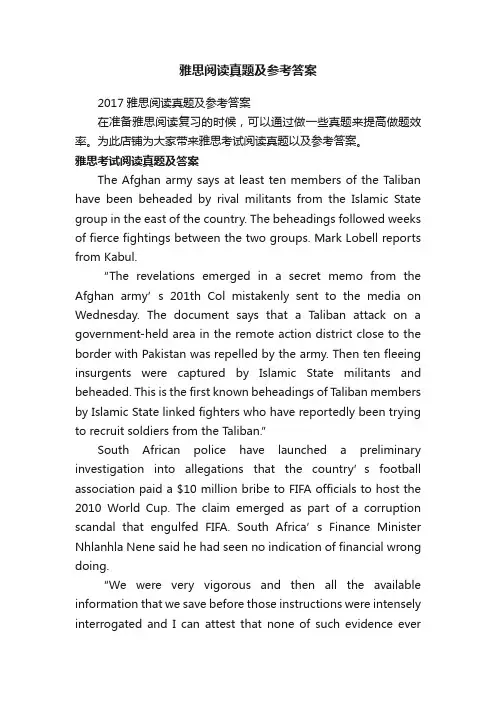
雅思阅读真题及参考答案2017雅思阅读真题及参考答案在准备雅思阅读复习的时候,可以通过做一些真题来提高做题效率。
为此店铺为大家带来雅思考试阅读真题以及参考答案。
雅思考试阅读真题及答案The Afghan army says at least ten members of the T aliban have been beheaded by rival militants from the Islamic State group in the east of the country. The beheadings followed weeks of fierce fightings between the two groups. Mark Lobell reports from Kabul.“The revelations emerged in a secret memo from the Afghan army’s 201th Col mistaken ly sent to the media on Wednesday. The document says that a Taliban attack on a government-held area in the remote action district close to the border with Pakistan was repelled by the army. Then ten fleeing insurgents were captured by Islamic State militants and beheaded. This is the first known beheadings of Taliban members by Islamic State linked fighters who have reportedly been trying to recruit soldiers from the Taliban.”South African police have launched a preliminary investigation into allegations that the country’s football association paid a $10 million bribe to FIFA officials to host the 2010 World Cup. The claim emerged as part of a corruption scandal that engulfed FIFA. South Africa’s Finance Minister Nhlanhla Nene said he had seen no indication of financial wrong doing.“We were very vigorous and then all the available information that we save before those instructions were intensely interrogated and I can attest that none of such evidence eversurfaced in those meetings.”Britain’s Sports Minister John Whittingdale says there’s a strong case for rerunning the bids to host the World Cup in 2018 and 2022 if there’s evidence of corruption. FIFA awarded the tournaments to Russia and Qatar.The Chinese authorities say they are planning to right the cruise ship that overturned in the Yangtze River on Monday. More than 450 people on board, but only 14 are known to have survived. From Jianli on the Yangtze River, John Sudworth reports.“The divers have been battling near 0 visibility and serious risks i n trying to search ship’s 150 compartments. The body recovery work had begun to gather pace after holes were cut into the Eastern Star’s exposed upturned hull allowing workers to enter from above, but it now seems the engineers have decided the best option is to raise the 4-decked cruise ship out of the water. Hooks have been well in the place and the net has been stretched around the entire structure.”Google has apologized to the India’s Prime Minister Narendra Modi after his photo appeared in Internet search results for the world’s top ten criminals. Here's Anberison at Rajkot."Google said the way images were described on the Internet could lead to surprising results to specific queries and they were not reflective of the opinions of the company. Google’s apology came after many Indian politicians and commentators expressed concern on social media. Despite the company’s apology, an image search for the world’s top ten criminals still shows pictures of Mr Modi alongside the wanted militants, murders and dictators."马里恩·马歇尔为你播报BBC新闻。
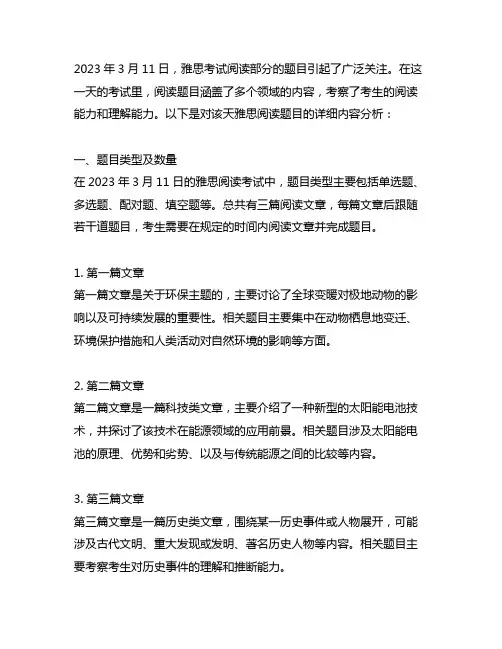
2023年3月11日,雅思考试阅读部分的题目引起了广泛关注。
在这一天的考试里,阅读题目涵盖了多个领域的内容,考察了考生的阅读能力和理解能力。
以下是对该天雅思阅读题目的详细内容分析:一、题目类型及数量在2023年3月11日的雅思阅读考试中,题目类型主要包括单选题、多选题、配对题、填空题等。
总共有三篇阅读文章,每篇文章后跟随若干道题目,考生需要在规定的时间内阅读文章并完成题目。
1. 第一篇文章第一篇文章是关于环保主题的,主要讨论了全球变暖对极地动物的影响以及可持续发展的重要性。
相关题目主要集中在动物栖息地变迁、环境保护措施和人类活动对自然环境的影响等方面。
2. 第二篇文章第二篇文章是一篇科技类文章,主要介绍了一种新型的太阳能电池技术,并探讨了该技术在能源领域的应用前景。
相关题目涉及太阳能电池的原理、优势和劣势、以及与传统能源之间的比较等内容。
3. 第三篇文章第三篇文章是一篇历史类文章,围绕某一历史事件或人物展开,可能涉及古代文明、重大发现或发明、著名历史人物等内容。
相关题目主要考察考生对历史事件的理解和推断能力。
以上是针对2023年3月11日雅思阅读题目的类型及数量的简要介绍,接下来将分别对这些题目类型进行详细分析。
二、文章分析1. 第一篇文章第一篇文章主题是环保,文章内容涉及全球变暖对极地动物的影响以及可持续发展的重要性。
考生在阅读这篇文章时,需要注意作者对环保问题的态度和观点,以及文章中提到的环保措施和相关数据。
题目类型主要包括单选题、多选题和配对题。
在做题时,考生需要综合文章内容,抓住核心信息,准确理解题目要求,并结合具体细节进行答题。
2. 第二篇文章第二篇文章主题是科技类,介绍了一种新型的太阳能电池技术及其应用前景。
考生需要在阅读文章时,理解太阳能电池技术的原理、优势和劣势,以及其与传统能源的比较。
相关题目类型主要包括填空题和多选题,考生需要在答题过程中,准确把握文章的关键信息,灵活运用所学知识,进行答题。
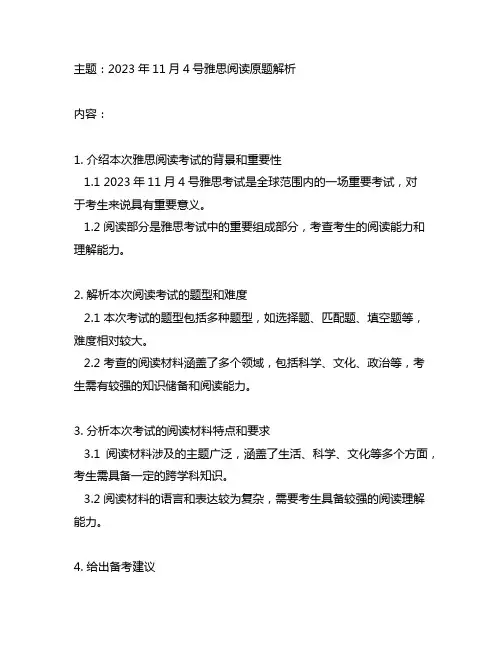
主题:2023年11月4号雅思阅读原题解析内容:1. 介绍本次雅思阅读考试的背景和重要性1.1 2023年11月4号雅思考试是全球范围内的一场重要考试,对于考生来说具有重要意义。
1.2 阅读部分是雅思考试中的重要组成部分,考查考生的阅读能力和理解能力。
2. 解析本次阅读考试的题型和难度2.1 本次考试的题型包括多种题型,如选择题、匹配题、填空题等,难度相对较大。
2.2 考查的阅读材料涵盖了多个领域,包括科学、文化、政治等,考生需有较强的知识储备和阅读能力。
3. 分析本次考试的阅读材料特点和要求3.1 阅读材料涉及的主题广泛,涵盖了生活、科学、文化等多个方面,考生需具备一定的跨学科知识。
3.2 阅读材料的语言和表达较为复杂,需要考生具备较强的阅读理解能力。
4. 给出备考建议4.1 建议考生在备考阶段注重积累词汇和阅读材料,提高阅读理解能力。
4.2 建议考生在平时多阅读英文报刊、杂志等,提高阅读速度和理解能力。
4.3 建议考生注重平时的练习,熟悉不同题型的解题技巧,提高应试能力。
5. 总结本次考试的重点和难点5.1 本次考试的重点在于考查考生的跨学科知识储备和阅读理解能力。
5.2 本次考试的难点在于阅读材料的复杂性和题型的多样性,需要考生具备较高的应试能力。
通过以上分析和解析,我们可以看出2023年11月4号雅思阅读考试的重要性以及考试的题型、难度和要求。
希望考生在备考过程中能够充分认识到考试的重要性,有针对性地进行备考,提高自己的阅读能力和应试能力,取得优异的成绩。
2023年11月4号雅思阅读考试的重要性不言而喻,对于很多留学和移民澳洲、加拿大等国家的考生来说,雅思成绩是他们申请学校或签证的必备条件。
而阅读部分作为整个考试的重要组成部分,对考生的阅读能力和理解能力有着很高的要求,因此备考阅读部分显得至关重要。
本次考试的题型多样,包括选择题、匹配题、填空题等。
这就要求考生不仅要具备良好的词汇量和阅读理解能力,还需要熟悉不同题型的解题技巧,这样才能更好地应对考试。
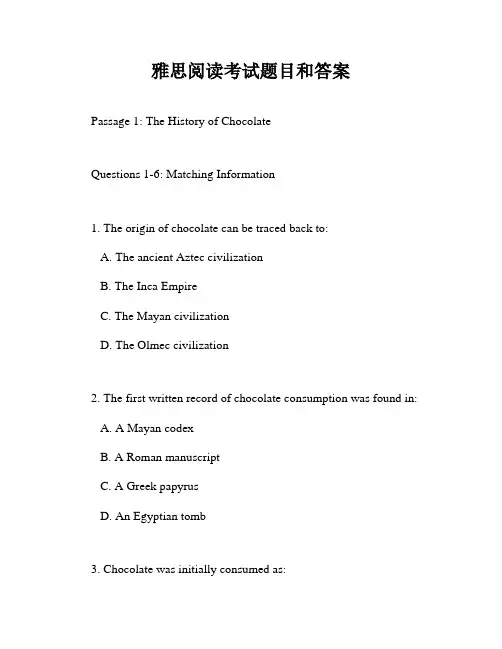
雅思阅读考试题目和答案Passage 1: The History of ChocolateQuestions 1-6: Matching Information1. The origin of chocolate can be traced back to:A. The ancient Aztec civilizationB. The Inca EmpireC. The Mayan civilizationD. The Olmec civilization2. The first written record of chocolate consumption was found in:A. A Mayan codexB. A Roman manuscriptC. A Greek papyrusD. An Egyptian tomb3. Chocolate was initially consumed as:A. A sweet treatB. A hot beverageC. A cold drinkD. A medicinal remedy4. The Spanish introduced chocolate to Europe in the:A. 15th centuryB. 16th centuryC. 17th centuryD. 18th century5. The process of making chocolate involved:A. Grinding cacao beansB. Roasting cacao beansC. Adding sugar to the mixtureD. All of the above6. The Industrial Revolution had a significant impact on:A. The quality of chocolateB. The production of chocolateC. The price of chocolateD. All of the aboveAnswers 1-6: CACDBQuestions 7-10: Multiple Choice7. What was the primary purpose of chocolate in ancient civilizations?A. As a luxury item for the eliteB. As a form of currencyC. As a religious offeringD. As a symbol of power8. How did the Spanish modify the original recipe of chocolate?A. By adding sugar and spicesB. By removing the chili peppersC. By substituting cacao with almondsD. By using milk instead of water9. What was the main challenge faced by early European chocolate makers?A. The high cost of cacao beansB. The lack of skilled laborC. The difficulty in grinding cacao beansD. The absence of a reliable supply chain10. What was the most significant technological advancement in chocolate production during the Industrial Revolution?A. The invention of the steam engineB. The development of the conching processC. The introduction of the hydraulic pressD. The use of the continuous conching machineAnswers 7-10: CADBPassage 2: The Impact of Social Media on Mental HealthQuestions 11-14: Sentence Completion11. Social media platforms can have both positive and negative effects on users' mental health, with some studies suggesting that excessive use can lead to _______.A. increased self-esteemB. decreased self-esteemC. improved social skillsD. enhanced creativity12. The comparison of oneself to others on social media can result in _______.A. a sense of accomplishmentB. a sense of belongingC. a sense of inadequacyD. a sense of superiority13. According to the article, one way to mitigate the negative effects of social media is to _______.A. limit the time spent on social mediaB. increase the frequency of postingC. follow more influential accountsD. share only positive experiences14. The article suggests that social media can be a useful tool for _______.A. self-promotionB. self-reflectionC. self-isolationD. self-destructionAnswers 11-14: BCADQuestions 15-20: True/False/Not Given15. Social media has no positive effects on mental health.True/False/Not Given16. The article claims that all social media users experience negative mental health outcomes.True/False/Not Given17. Limiting social media use can improve mental well-being.True/False/Not Given18. The article states that social media is solely responsible for mental health issues.True/False/Not Given19. The article mentions that social media can be a platform for self-expression.True/False/Not Given20. The article suggests that social media can exacerbate existing mental health conditions.True/False/Not GivenAnswers 15-20: False/False/True/False/True/TruePassage 3: Renewable Energy and the EnvironmentQuestions 21-26: Headings21. Paragraph A: The current state of renewable energy sourcesA. iB. iiC. iiiD. iv22. Paragraph B: The environmental benefits of renewable energyA. iB. iiC. iiiD. iv23. Paragraph C: The challenges faced by renewable energy technologiesA. iB. iiD. iv24. Paragraph D: The role of government policies in promoting renewable energyA. iB. iiC. iiiD. iv25. Paragraph E: The future prospects of renewable energyA. iB. iiC. iiiD. iv26. Paragraph F: The economic impact of renewable energy on societyA. iC. iiiD. ivAnswers 21-26: B/C/D/A/E/FQuestions 27-30: SummaryComplete the summary using the information from the passage.Renewable energy sources, such as solar and wind power, have become increasingly popular due to their potential to reduce greenhouse gas emissions and combat climate change. However, the transition to renewable energy is not without its challenges, including the intermittent nature of some energy sources and the need for significant infrastructure investment. Governments play a crucial role in supporting the development of renewable energy through policies and incentives, which can help to overcome these obstacles. The future of renewable energy looks promising, with advancements in technology and a growing global commitment to sustainability. This shift towards cleaner energy sources is expected to have a positive economic impact, creating new jobs and stimulating economic growth.Answers 27-30: solar, wind power, greenhouse gas emissions, climate change, intermittent, infrastructure investment, policies, incentives, technology, sustainability, jobs, economic growth.。
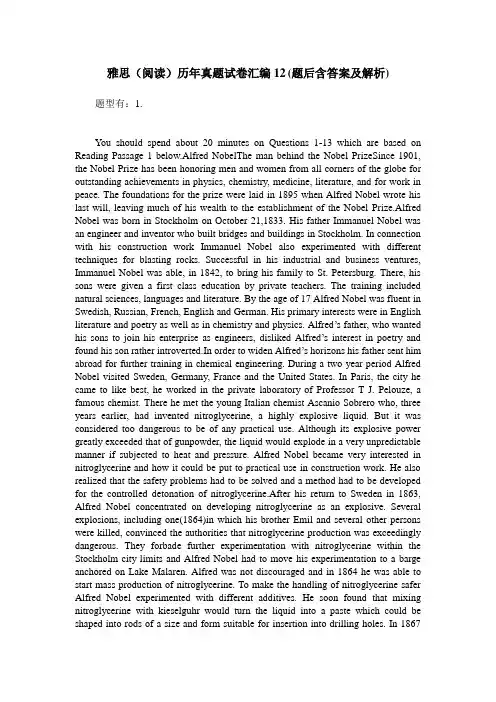
雅思(阅读)历年真题试卷汇编12(题后含答案及解析) 题型有:1.You should spend about 20 minutes on Questions 1-13 which are based on Reading Passage 1 below.Alfred NobelThe man behind the Nobel PrizeSince 1901, the Nobel Prize has been honoring men and women from all corners of the globe for outstanding achievements in physics, chemistry, medicine, literature, and for work in peace. The foundations for the prize were laid in 1895 when Alfred Nobel wrote his last will, leaving much of his wealth to the establishment of the Nobel Prize.Alfred Nobel was born in Stockholm on October 21,1833. His father Immanuel Nobel was an engineer and inventor who built bridges and buildings in Stockholm. In connection with his construction work Immanuel Nobel also experimented with different techniques for blasting rocks. Successful in his industrial and business ventures, Immanuel Nobel was able, in 1842, to bring his family to St. Petersburg. There, his sons were given a first class education by private teachers. The training included natural sciences, languages and literature. By the age of 17 Alfred Nobel was fluent in Swedish, Russian, French, English and German. His primary interests were in English literature and poetry as well as in chemistry and physics. Alfred’s father, who wanted his sons to join his enterprise as engineers, disliked Alfred’s interest in poetry and found his son rather introverted.In order to widen Alfred’s horizons his father sent him abroad for further training in chemical engineering. During a two year period Alfred Nobel visited Sweden, Germany, France and the United States. In Paris, the city he came to like best, he worked in the private laboratory of Professor T J. Pelouze, a famous chemist. There he met the young Italian chemist Ascanio Sobrero who, three years earlier, had invented nitroglycerine, a highly explosive liquid. But it was considered too dangerous to be of any practical use. Although its explosive power greatly exceeded that of gunpowder, the liquid would explode in a very unpredictable manner if subjected to heat and pressure. Alfred Nobel became very interested in nitroglycerine and how it could be put to practical use in construction work. He also realized that the safety problems had to be solved and a method had to be developed for the controlled detonation of nitroglycerine.After his return to Sweden in 1863, Alfred Nobel concentrated on developing nitroglycerine as an explosive. Several explosions, including one(1864)in which his brother Emil and several other persons were killed, convinced the authorities that nitroglycerine production was exceedingly dangerous. They forbade further experimentation with nitroglycerine within the Stockholm city limits and Alfred Nobel had to move his experimentation to a barge anchored on Lake Malaren. Alfred was not discouraged and in 1864 he was able to start mass production of nitroglycerine. To make the handling of nitroglycerine safer Alfred Nobel experimented with different additives. He soon found that mixing nitroglycerine with kieselguhr would turn the liquid into a paste which could be shaped into rods of a size and form suitable for insertion into drilling holes. In 1867he patented this material under the name of dynamite. To be able to detonate the dynamite rods he also invented a detonator(blasting cap)which could be ignited by lighting a fuse. These inventions were made at the same time as the pneumatic drill came into general use. Together these inventions drastically reduced the cost of blasting rock, drilling tunnels, building canals and many other forms of construction work.The market for dynamite and detonating caps grew very rapidly and Alfred Nobel also proved himself to be a very skillful entrepreneur and businessman. Over the years he founded factories and laboratories in some 90 different places in more than 20 countries. Although he lived in Paris much of his life he was constantly traveling. When he was not traveling or engaging in business activities Nobel himself worked intensively in his various laboratories, first in Stockholm and later in other places. He focused on the development of explosives technology as well as other chemical inventions, including such materials as synthetic rubber and leather, artificial silk, etc. By the time of his death in 1896 he had 355 patents.Intensive work and travel did not leave much time for a private life. At the age of 43 he was feeling like an old man. At this time he advertised in a newspaper “Wealthy, highly-educated elderly gentle-man seeks lady of mature age, versed in languages, as secretary and supervisor of household.” The most qualified applicant turned out to be an Austrian woman, Countess Bertha Kinsky. After working a very short time for Nobel she decided to return to Austria to marry Count Arthur von Suttner. In spite of this Alfred Nobel and Bertha von Suttner remained friends and kept writing letters to each other for decades. Over the years Bertha von Suttner became increasingly critical of the arms race. She wrote a famous book, Lay Down Your Arms and became a prominent figure in the peace movement. No doubt this influenced Alfred Nobel when he wrote his final will which was to include a Prize for persons or organizations who promoted peace. Several years after the death of Alfred Nobel, the Norwegian Storting(Parliament)decided to award the 1905 Nobel Peace Prize to Bertha von Suttner.Alfred Nobel died in San Remo, Italy, on December 10, 1896. When his will was opened it came as a surprise that his fortune was to be used for Prizes in Physics, Chemistry, Physiology or Medicine, Literature and Peace. The executors of his will were two young engineers, Ragnar Sohlman and Rudolf Lilljequist. They set about forming the Nobel Foundation as an organization to take care of the financial assets left by Nobel for this purpose and to coordinate the work of the Prize-Awarding Institutions. This was not without its difficulties since the will was contested by relatives and questioned by authorities in various countries.Alfred Nobel’s greatness lay in his ability to combine the penetrating mind of the scientist and inventor with the forward-looking dynamism of the industrialist. Nobel was very interested in social and peace-related issues and held what were considered radical views in his era. He had a great interest in literature and wrote his own poetry and dramatic works. The Nobel Prizes became an extension and a fulfillment of his lifetime interests.Questions 1-6Do the following statements agree with the information given in Reading Passage 1? In boxes 1-6 on your answer sheet, writeTRUE if the statement agrees with the informationFALSE if the statement contradicts the informationNOT GIVEN if there is no information on this1.The first Nobel Prize was awarded in 1895.A.真B.假C.Not Given正确答案:B解析:利用细节信息“1895”和顺序性原则很容易定位到原文第一段。
雅思考试阅读全面解析及答案(21)THE GAP of INGENUITY 2Ingenuity, as I define it here, consists not only of ideas for new technolo gies like computers or drought-resistant crops but, more fundamentally, of idea s for better institutions and social arrangements, like efficient markets and c ompetent governments.How much and what kinds of ingenuity a society requires depends on a range of factors, including the society's goals and the circumstances within which it must achieve those goals——whether it has a young population or an aging one, an abundance of natural resources or a scarcity of them, an easy climate or a punishing one, whatever the case may be.How much and what kinds of ingenuity a society supplies also depends on man y factors, such as the nature of human inventiveness and understanding, the rew ards an economy gives to the producers of useful knowledge, and the strength of political opposition to social and institutional reforms.A good supply of the right kind of ingenuity is essential, but it isn't, of course, enough by itself. We know that the creation of wealth, for example, de pends not only on an adequate supply of useful ideas but also on the availabili ty of other, more conventional factors of production, like capital and labor. S imilarly, prosperity, stability and justice usually depend on the resolution, o r at least the containment, of major political struggles over wealth and power. Yet within our economics ingenuity often supplants labor, and growth in the st ock of physical plant is usually accompanied by growth in the stock of ingenuit y. And in our political systems, we need great ingenuity to set up institutions that successfully manage struggles over wealth and power. Clearly, our economi c and political processes are intimately entangled with the production and use of ingenuity.The past century’s countless incremental changes in our societies around t he planet, in our technologies and our interactions with our surrounding natura l environments have accumulated to create a qualitatively new world. Because these changes have accumulated slowly, It’s often hard for us to recognize how p rofound and sweeping they've. They include far larger and denser populations; m uch higher per capita consumption of natural resources; and far better and more widely available technologies for the movement of people, materials, and espec ially information.In combination, these changes have sharply increased the density, intensity, and pace of our inter actions with each other; they have greatly increased the burden we place on our natural environment; and they have helped shift power f rom national and international institutions to individuals and subgroups, such as political special interests and ethnic factions.As a result, people in all walks of life-from our political and business le aders to all of us in our day-to-day——must cope with much more complex, urgen t, and often unpredictable circumstances. The management of our relationship wi th this new world requires immense and ever-increasing amounts of social and te chnical ingenuity. As we strive to maintain or increase our prosperity and impr ove the quality of our lives, we must make far more sophisticated decisions, an d in less time, than ever before.When we enhance the performance of any system, from our cars to the planet' s network of financial institutions, we tend to make it more complex. Many of t he natural systems critical to our well-being, like the global climate and the oceans, are extraordinarily complex to begin with. We often can't predict or ma nage the behavior of complex systems with much precision, because they are ofte n very sensitive to the smallest of changes and perturbations, and their behavi or can flip from one mode to another suddenly and dramatically. In general, as the human-made and natural systems we depend upon become more complex, and as o ur demands on them increase, the institutions and technologies we use to manage them must become more complex too, which further boosts our need for ingenuit y.The good news, though, is that the last century's stunning changes in our s ocieties and technologies have not just increased our need for ingenuity; they have also produced a huge increase in its supply. The growth and urbanization o f human populations have combined with astonishing new communication and transp ortation technologies to expand interactions among people and produce larger, more integrated, and more efficient markets. These changes have, in turn, vastly accelerated the generation and delivery of useful ideas.But—and this is the critical "but"——we should not jump to the conclusion that the supply of ingenuity always increases in lockstep with our ingenuity r equirement: While it's true that necessity is often the mother of invention, we can't always rely on the right kind of ingenuity appearing when and where we n eed it. In many cases, the complexity and speed of operation of today's vital e conomic, social, arid ecological systems exceed the human brains grasp. Very fe w of us have more than a rudimentary understanding of how these systems work. T hey remain fraught with countless "unknown unknowns," which makes it hard to su pply the ingenuity we need to solve problems associated with these systems.In this book, explore a wide range of other factors that will limit our abi lity to supply the ingenuity required in the coming century. For example, many people believe that new communication technologies strengthen democracy and wil l make it easier to find solutions to our societies' collective problems, but t he story is less clear than it seems. The crush of information in our everyday lives is shortening our attention span, limiting the time we have to reflect on critical matters of public policy, and making policy arguments more superficia l.Modern markets and science are an important part of the story of how we sup ply ingenuity. Markets are critically important, because they give entrepreneur s an incentive to produce knowledge. As for science, although it seems to face no theoretical limits, at least in the foreseeable future, practical constraint s often slow its progress. The cost of scientific research tends to increase as it delves deeper into nature. And science's rate of advance depends on the cha racteristic of the natural phenomena it investigates, simply because some pheno mena are intrinsically harder to understand than others, so the production of u seful new knowledge in these areas can be very slow. Consequently, there is oft en a critical time lag between the recognition between a problem and the delive ry of sufficient ingenuity, in the form of technologies, to solve that problem. Progress in the social sciences is especially slow, for reasons we don't yet u nderstand; but we desperately need better social scientific knowledge to build the sophisticated institutions today’s world demands.Questions:Complete each sentence with the appropriate answer, A, B, C, or DWrite the correct answer in boxes 27-30 on your answer sheet.27 The definition of ingenuity28 The requirement for ingenuity29 The creation of social wealth30 The stability of societyA depends on many factors including climate.B depends on the management and solution of disputes.C is not only of technological advance, but more of institutional renovatio n.D also depends on the availability of some traditional resources.Question 31-33Choose the correct letter, A, B, C, or D.Write your answers in boxes 31-33 on your answer sheet.31 What does the author say about the incremental change of the last 100 ye ars?A It has become a hot scholastic discussion among environmentalists.B Its significance is often not noticed.C It has reshaped the natural environments we live in.D It benefited a much larger population than ever.32 The combination of changes has made life.A easierB fasterC slowerD less sophisticated33 What does the author say about the natural systems?A New technologies are being developed to predict change with precision.B Natural systems are often more sophisticated than other systems.C Minor alterations may cause natural systems to change dramatically.D Technological developments have rendered human being more independent of natural systems.Question 34-40Do the following statements agree with the information given in Reading Pas sage 3?In boxes 34-40 on your answer sheet, writeYES if the statement is trueNO if the statement is falseNOT GIVEN if the information is not given in the passage34 The demand for ingenuity has been growing during the past 100 years.35 The ingenuity we have may be inappropriate for solving problems at hand.36 There are very few who can understand the complex systems of the present world.37 More information will help us to make better decisions.38 The next generation will blame the current government for their conduct.39 Science tends to develop faster in certain areas than others.40 Social science develops especially slowly because it is not as important as natural science.参考译文:创新过程的空白创造,就像笔者在这里定义的一样,不仅仅指那些关于计算机、抗早作物之类的新科技的构想,更重要的是指那些关于优化制度和社会安排的思想,例如高效市场、法定政府等。
雅思阅读实战训练题及答案题目1题目:下面哪个选项最能够概括该篇文章的主题?A. 环境保护的重要性B. 气候变化对人类的影响C. 可再生能源的发展和应用D. 城市化对自然环境的破坏答案:B. 气候变化对人类的影响题目2题目:根据文章的内容,以下哪个陈述是正确的?A. 气候变化是自然现象,与人类活动无关B. 可再生能源在全球范围内已经得到广泛应用C. 城市化有助于减少温室气体排放D. 气候变化会导致海平面上升答案:D. 气候变化会导致海平面上升题目3题目:根据文章的内容,以下哪个选项是正确的?A. 可再生能源是目前最主要的能源来源B. 煤炭和石油是最干净的能源形式C. 可再生能源的开发受到了政府的积极支持D. 气候变化对动植物的生存环境没有影响答案:C. 可再生能源的开发受到了政府的积极支持题目4题目:根据文章的内容,以下哪个选项不是可再生能源的例子?A. 太阳能B. 风能C. 水能D. 煤炭答案:D. 煤炭题目5题目:根据文章的内容,以下哪个选项是正确的?A. 城市化对自然环境没有任何负面影响B. 煤炭和石油是最常用的可再生能源C. 气候变化是由于自然灾害造成的D. 现代城市化导致了许多环境问题答案:D. 现代城市化导致了许多环境问题题目6题目:根据文章的内容,以下哪个选项是正确的?A. 可再生能源在全球范围内得到了广泛应用B. 气候变化对人类健康没有任何影响C. 城市化有助于减少自然灾害的发生D. 气候变化是由于人类活动引起的答案:D. 气候变化是由于人类活动引起的结束语以上是本次的雅思阅读实战训练题及答案,希望对您的备考有所帮助。
请继续努力,加油!。
2019年8月1日雅思阅读考试真题及解析八月的第一场雅思考试已经顺利地落下了帷幕,可以说是有人欢喜有人愁。
今天就跟着店铺来一起看看2019年8月1日雅思阅读考试真题及解析。
Passage1:非洲某个国家的农业参考原文及答案:A By tradition land in Luapula is not owned by individuals,but as in many other parts of Africa is allocated by the headman or headwoman of a village to people of either sex, according to need. Since land is generally prepared by hand,one ulupwa cannot take on a very large area; in this sense land has not been a limiting resource over large parts of the province. The situation has already changed near the main townships, and there has long been a scarcity of land for cultivation in the Valley. In these areas registered ownership patterns are becoming prevalent.B Most of the traditional cropping in Luapula,as in the Bemba area to the east,is based on citemene,a system whereby crops are grown on the ashes of tree branches. As a rule,entire trees are not felled (v. 砍到),but are pollarded (v. 截去树梢)so that they can regenerate. Branches are cut over an area of varying size early in the dry season, and stacked to dry over a rough circle about a fifth to a tenth of the pollarded area. The wood is fired before the rains and in the first year planted with the African cereal finger millet (Eleusine coracana). The grain of this crop is used to brew local beers such as cipumu, which contribute several vitamins of the B complex to peoples’ diet. Cipumu is also used in cementing reciprocal working relationships (Pottier 1985).C During the second season, and possibly for a few seasonsmore the area is planted to variously mixed combinations of annuals (n. 一年生植物)such as maize,pumpkins (Telfiria occidentalis)and other cucurbits,sweet potatoes,groundnuts,Phaseolus beans and various leafy vegetables,grown with a certain amount of rotation (n. 轮流). The diverse sequence ends with vegetable cassava, which is often planted into the developing last-but-one crop as a relay.D Richards (1969) observed that the practice of citemene entails a definite division of labour between men and women. A man stakes out a plot in an unobtrusive manner,since it is considered provocative towards one’s neighbours to mark boundaries in an explicit way. The dangerous work of felling branches is the m en’s province,and involves much pride. Branches are stacked by the women,and fired by the men. Formerly women and men cooperated in the planting work, but the harvesting was always done by the women. At the beginning of the cycle little weeding is necessary, since the firing of the branches effectively destroys weeds. As the cycle progresses weeds increase and nutrients eventually become depleted to a point where further effort with annual crops is judged to be not worthwhile: at this point the cassava is planted, since it can produce a crop on nearly exhausted soil. Thereafter the plot is abandoned,and a new area pollarded for the next citemene cycle.E When forest is not available-this is increasingly the case nowadays-various ridging systems (ibala)are built on small areas,to be planted with combinations of maize,beans,groundnuts and sweet potatoes, usually relayed with cassava. These plots are usually tended by women,and provide subsistence. Where their roots have year-round access to watertables (n. 地下水位、潜水面)mango, guava and oil-palm trees often grow around houses, forming a traditional agroforestry (n. 农林业)system. In season some of the fruit is sold by the roadside or in local markets.F The margins of dambos are sometimes planted to local varieties of rice during the rainy season, and areas adjacent to vegetables irrigated with water from the dambo during the dry season. The extent of cultivation is very limited,no doubt because the growing of crops under dambo conditions calls for a great deal of skill (Dougnac 1987:9-10). Near towns some of the vegetable produce is sold in local markets.G Fishing has long provided a much needed protein supplement (n. 补充)to the diet of Luapulans, as well as being the one substantial source of cash. Much fish is dried for sale to areas away from the main waterways. The Mweru and Bangweulu Lake Basins are the main areas of year-round fishing, but the Luapula River is also exploited (v. 开采)during the latter part of the dry season. Several previously abundant and desirable species,such as the Luapula salmon or mpumbu (Labeo altivelis)and pale (Sarotherodon machochir)have all but disappeared from Lake Mweru,apparently due to mismanagement (Huckaby 1979).H Fishing has always been a far more remunerative activity in Luapula that crop husbandry (n. 农业、资源管理). A fisherman may earn more in a week than a bean or maize grower in a whole season. I sometimes heard claims that the relatively high earnings to be obtained from fishing induced an‘ easy come,easy go’ outlook a mong Luapulan men. On the other hand, someone who secures good but erratic earnings may feel that their investment in an economically productive activity is notworthwhile because Luapulans fail to cooperate well in such activities. Besides, a fisherman with spare cash will find little in the way of working equipment to spend his money on. Better spend one’s money in the bars and have a good time!I Only small numbers of cattle or oxen are kept in the province owing to the prevalence of the tse-tse fly. For the few herds, the dambos provide subsistence grazing during the dry season. The absence of animal draft power greatly limits peoples’ ability to plough (n. 耕、犁)and cultivate land:a married couple an rarely manage to prepare by hand-hoeing.J Most people keep freely roaming chickens and goats. These act as a reserve for bartering (物物交换),but may also be occasionally slaughtered for ceremonies or for entertaining important visitors. These animals are not a regular part of most peoples’ diet.K Citemene has been an ingenious system for providing people with seasonal production of high quality cereals and vegetables in regions of acid, heavily leached soils. Nutritionally,the most serious deficiency was that of protein. This could at times be alleviated when fish was available,provided that cultivators lived near the Valley and could find the means of bartering for dried fish. The citemene/fishing system was well adapted to the ecology of the miombo regions and sustainable for long periods,but only as long as human population densities stayed at low levels.L Although population densities are still much lower than in several countries of South-East Asia, neither the fisheries nor the forests and woodlands of Luapula are capable,with unmodified traditional practices,of supporting the people in sustainable manner. For instance,even in a normal seasonpeople suffer from a lack of energy,protein,vitamins and minerals in the diet. A third of under-five children brought to clinics are either stagnant (adj. 停滞的)in growth, or are losing weight.M Overall, people must learn to intensify and diversify their productive systems while yet ensuring that these systems will remain productive in the future, when even more people will need food. Increasing overall production of food, though a vast challenge in itself, will not be enough, however. At the same time storage and distribution systems must allow everyone access to at least a moderate share of the total.Questions 1-4 .................................................................................Complete the sentences below with words taken from Reading Passage 1.Choose NO MORE THAN TWO WORDS from the passage for each answer.Write your answers in boxes 1-4 on your answer sheet.1 In Luapula land allocation is in accordance with2 The citemene system provides the land with where crops are planted.3 During the second season, the last planted crop is4 Under suitable conditions, fruit trees are planted nearQuestions 5-8 .................................................................................Classify the following items with the correct description.Write your answers in boxes 5-8 on your answer sheetA fishB oxenC goats5 be used in some unusual occasions, such as celebrations.6 cannot thrive for being affected by the pests.7 be the largest part of creating profit.8 be sold beyond the local area.Questions 9-12 ...............................................................................Do the following statements agree with the information given in Reading Passage 1?In boxes 9-12 on your answer sheet, writeTRUE if the sataement agrees with the informationFALSE if the statement contradicts the informationNOT GIVEN if there is no information on this9 People rarely use animals to cultivate land.10 The local residents eat goats on a regular time.11 When it is a busy time, children are usually taken as the labor force.12 Though citemene has been a sophisticated system,it could not provide enough protein.Questions 13 ...................................................................................Choose the correct letter, A, B, C or D.Write the correct letter in the box 13 on your answer sheet.What is the writer’s opinion about the traditional ways of practices?A They can supply the nutrition that people need.B They are not capable of providing adequate support to the population.C They are productive systems that need no more improving.D They will be easily modified in the future.1. need2. ashes3. vegetable cassava4. houses5. C6. B7. A8. A9. TRUE10. FALSE11. NOT GIVEN12. TRUE13. BPassage2:考古发现古埃及水下遗迹参考答案:待补充Passage3: facial expression面部表情参考原文及答案:A A facial expression is one or more motions or positions of the muscles in the skin. These movements convey the emotional state of the individual to observers. Facial expressions are a form of nonverbal communication. They are a primary means of conveying social information among aliens, but also occur in most other mammals (哺乳动物)and some other animal species. Facial expressions and their significance in the perceiver can, to some extent, vary between cultures with evidence from descriptions in the works of Charles Darwin.B Humans can adopt a facial expression to read as a voluntary action. However, cause expressions are closely tied to emotion, they are more often involuntary (不知不觉的). It can be nearly impossible to avoid expressions for certain emotions,even when it would be strongly desirable to do so; a person who is trying to avoid insulting an individual he or she finds highly unattractive might ,nevertheless,show a brief expression of disgust before being able to reassume a neutral expression. Microexpressions(微表情)are one example of thisphenomenon. The close link between emotion and expression can also work in the other direction; it has been observed that voluntarily assuming an expression can actually cause the associated emotion.C Some expressions can be accurately interpreted even between members of different species- anger and extreme contentment (满足,满意)being the primary examples . Others ,however,are difficult to interpret even in familiar individuals. For instance, disgust and fear can be tough to tell apart. Because faces have only a limited range of movement,expressions rely upon fairly minuscule differences in the proportion and relative position of facial features, and reading them requires considerable sensitivity to same. Some faces are often falsely read as expressing some emotion, even when they are neutral, because their proportions naturally resemble those another face would temporarily assume.D Also, a person 1s eyes reveal much about how they are feeling,or what they are thinking. Blink rate(眨眼率)can reveal how nervous or at ease a person may be. Research by Boston College professor Joe Tecce suggests that stress levels are revealed by blink rates. He- supports his data with statistics on the relation between the blink rates of presidential candidates and their success in their races. Tecce claims that the faster blinker in the presidential debates has lost every election since 1980. Though Tecce 1 s data is interesting,it is important to recognize that non-verbal communication is multi-channeled,and focusing on only one aspect is reckless. Nervousness can also be measured by examining each candidates’ perspiration,eye contact and stiffness.E As Charles Darwin noted in his book The Expression of theEmotions in Man and Animals:the young and the old of widely different races, both with man and animals, express the same state of mind by the same movements. Still, up to the mid—20th century most anthropologists (人类学家)believed that facial expressions were entirely learned and could therefore differ among cultures. Studies conducted in the 1960s by Paul Ekman eventually supported Darwin’s belief to a large degree.F Ekman’s work on facial expressions had its starting point in the work of psychologist Silvan Tomkins. Ekman showed that contrary to the belief of some anthropologists including Margaret Mead, facial expressions of emotion are not culturally determined,but universal across human cultures. The South Fore people of New Guinea were chosen as subjects for one such survey. The study consisted of 189 adults and 130 children from among a very isolated population,as well as twenty three members of the culture who lived a less isolated lifestyle as a control group. Participants were told a story that described one particular emotion; they were then shown three pictures (two for children)of facial expressions and asked to match the picture which expressed the story’s emotion.G While the isolated South Fore people could identify emotions with the same accuracy as the non-isolated control group, problems associated with the study include the fact that both fear and surprise were constantly misidentified. The study concluded that certain facial expressions correspond to particular emotions and can not be covered,regardless of cultural background,and regardless of whether or not the culture has been isolated or exposed to the mainstream.H Expressions Ekman found to be universal included those indicating anger, disgust, fear, joy, sadness, and surprise(note that none of these emotions has a definitive social component,such as shame,pride,or schadenfreude). Findings on contempt (which is social) are less clear, though there is at least some preliminary evidence that this emotion and its expression are universally recognized. This may suggest that the facial expressions are largely related to the mind and each parts on the face can express specific emotion.Questions 28-32 .............................................................................SummaryComplete the Summary paragraph described below. In boxes 28-33 on your answer sheet, write the correct answer with NO MORE THAN TWO WORDSThe result of Ekman’s study demonstrates that fear and surprise are persistently 28 and made a conclusion that some facial expressions have something to do with certain 29 which is impossible covered,despite of 29 and whether the culture has been 30 or 31 to the mainstream.Questions 33-38 .............................................................................The reading Passage has seven paragraphs A-H.Which paragraph contains the following information?Write the correct letter J-J^ in boxes 34-38 on your answer sheet.NB You may use any letter more than once.33 the difficulty identifying the actual meaning of facial expressions34 the importance of culture on facial expressions35 collected data for the research on the relation between blink and the success in elections36 impossible to differentiate some closely related expressions37 an i ndicator to reflect one’s extent of nervousness38 the relation between emotion and facial expressionsQuestions 39-40 .............................................................................Choose two letters from the A-EWrite your answers in boxes 39-40 on your answer sheet.Which Two of the following statements are true according to Ekman’s theory?A No evidence shows animals have their own facial expressions.B Mind controls man’s facial expressions.C Facial expressions are concerning different cultures.D Different spots on face convey certain state of mind.E The definite relationship between facial expressions and state of mind exists28. misidentified29. emotions30. cultural background31. isolated32. exposed33. C34. A35. D36. H37. D38. B39. B40. D。
2023年5月20日雅思考试真题及解析一、雅思听力部分Part 1考察内容:儿童书店求职考察题型:填空题+配对题Questions 1-3 completion1. Address: 52, Acacia Avenue2. Postcode: 6RA 7BU3. Subject: PhotographyQuestions 4-6 table completionQuestions 7-10 matchingIs she available?A. Yes, definitely availableB. PossiblyC. No, definitely unavailable7. Weekends: A8. After 7pm: C9. Holiday: A10. Lunch time: B本篇P1部分出现低概率题型—配对题,但难度不高,总体考察对于态度的判断。
可参考剑桥7TEST4PART3以及剑桥8TEST3PART3题目。
注意拼写,积累单词。
本篇最早出现在2009年4月18日内地考试中。
Part 2《航道雅思听力速递机经》P2P3部分第129页第149篇考察内容:澳大利亚小岛旅游考察题型:填空+配对本篇考察单词不难,注意数字部分可能存在干扰考点。
作为本次考试的第二组配对题,选项出现较多,核心考察对替换结合语境的判断。
注意通过剑桥系列积累替换类型。
Part 3考察内容:学术讨论考察题型:选择题本篇回忆暂缺Part 4考察内容:书写的历史考察题型:笔记填空题31. made of bones32. feathers33. use ink34. and paper35. to make it suitable for writing HB to mark how hard it is36. part is fixed by strings or steel37. producers marked a name on the pencil to38. the pencil core is thought to be lead39. made the mixture of graphite in a form of clay powder and wax40. remove unwanted base on the oil注意按照语境积累词汇和用词搭配。
雅思阅读试题练习与答案全解析
简介
本文档旨在提供全面的雅思阅读试题练与答案的解析,帮助考生更好地准备雅思考试。
阅读练与答案解析
以下是一系列的雅思阅读练题目及其答案解析:
题目1:
题目:根据短文内容,回答以下问题:XXXXX
答案:根据短文第X段,可以得出答案为XXXXX。
解析:在这个题目中,我们需要从短文中寻找相关信息来回答问题。
根据短文第X段的描述,我们可以得出答案为XXXXX。
题目2:
题目:根据短文内容,判断以下陈述是否正确:XXXXX
答案:正确
解析:在这个题目中,我们需要判断陈述的正确性。
根据短文第X段的描述,我们可以得出陈述为正确。
题目3:
题目:根据短文内容,选择最佳的选项:XXXXX
答案:B
解析:在这个题目中,我们需要根据短文的内容选择最佳的选项。
根据短文第X段的描述,选项B最符合短文的意思。
总结
本文提供了一系列的雅思阅读练题目及其答案解析,帮助考生进行针对性的练和复。
阅读理解是雅思考试中的重要部分,通过对题目和答案的解析,考生可以更好地理解和掌握解题技巧,提高阅读能力。
希望考生能够充分利用这些练题目,并在考试中取得好成绩!。
2019年9月12日雅思阅读考试真题及答案最新一期的雅思考试圆满结束,那么考试的真题和答案是怎样的呢?来跟着看一看2019年9月12日雅思阅读考试真题及答案。
Reading Passage 1Title:印第安文明古迹Question types:待补充文章内容回顾待补充题型难度及技巧分析对于文化类的考察,放在第一篇的位置相对而言,对于考生而言还是比较友好的,尤其是针对古迹一类的词汇,学生相对而言应该还是比较熟悉的,类似于Relic这样的生词,考前应该完全熟悉并且做到心中有数。
具体可参考文章:C13——TEST3 Passage3 Whatever happened to the Harappan Civilisation?Reading Passage 2Title:人类和人工智能的结合在太空探索中的应用Question types:待补充文章内容回顾待补充题型难度及技巧分析本篇文章相对而言还是比较简单的,在文章的理解上面首先就不是很难,其次在文章当中一直会重复出现AI等平时常见的生词,因此对于学生做题在信心上面也是很有帮助的,对待这篇文章,最重要的就是要做到定定心心。
但是把握好时间。
具体可参考文章:C9——TEST1 Passage2 Is anybody out there?Reading Passage 3Title:科技爆炸带来的负面影响Question types:待补充文章内容回顾具体可参考这一篇类似的文章:Alexander Henderson (1831-1913)Born in Scotland, Henderson emigrated to Canada in 1855 and became a well-known landscape photographer.Alexander Henderson was born in Scotland in 1831 and was the son of a successful grandfather,also called Alexander,had founded the family business,and later became the first chairman of the National Bank of Scotland. The family had extensive landholdings in Scotland. Besides its residence in Edinburgh, it owned Press Estate, 650 acres of farmland about 35 miles southeast of the city. The family often stayed at Press Castle, the large mansion on the northern edge of the property,and Alexander spent much of his childhood in the area, playing on the beach near Eyemouth or fishing in the streams nearby.Even after he went to school at Murcheston Academy on the outskirts of Edinburgh,Henderson returned to Press at weekends. In 1849 he began a three-year apprenticeship to become an accountant. Although he never liked the prospect of a business career,he stayed with it to please his family. In October 1855, however, he emigrated to Canada with his wife Agnes Elder Robertson and they settled in Montreal.Henderson learned photography in Montreal around theyear 1857 and quickly took it up as a serious amateur. He became a personal friend and colleague of the Scottish- Canadian photographer William Notman. The two men made a photographic excursion to Niagara Falls in 1860 and they cooperated on experiments with magnesium flares as a source of artificial light in 1865. They belonged to the same societies and were among the founding members of the Art Association of Montreal. Henderson acted as chairman of the association's first meeting,which was held in Notman's studio on 11 January 1860.In spite of their friendship, their styles of photography were quite e Notman's landscapes were noted for their bold realism,Henderson for the first 20 years of his career produced romantic images, showing the strong influence of the British landscape tradition. His artistic and technical progress was rapid and in 1865 he published his first major collection of landscape publication had limited circulation (only seven copies have ever been found), and was called Canadian Views and contents of each copy vary significantly and have proved a useful source for evaluating Henderson's early work.In 1866, he gave up his business to open a photographic studio,advertising himself as a portrait and landscape photographer. From about 1870 he dropped portraiture to specialize in landscape photography and other views. His numerous photographs of city life revealed in street scenes,houses,and markets are alive with human activity,and although his favourite subject was landscape he usually composed his scenes around such human pursuits as farming the land, cutting ice on a river, or sailing down a woodland stream. There was sufficient demand for these types of scenes and othershe took depicting the lumber trade, steamboats and waterfalls to enable him to make a living. There was little competing hobby or amateur photography before the late 1880s because of the time-consuming techniques involved and the weight of the equipment. People wanted to buy photographs as souvenirs of a trip or as gifts, and catering to this market, Henderson had stock photographs on display at his studio for mounting,framing, or inclusion in albums.Henderson frequently exhibited his photographs in Montreal and abroad,in London,Edinburgh,Dublin,Paris,New York, and Philadelphia. He met with greater success in 1877 and 1878 in New York when he won first prizes in the exhibition held by E and H T Anthony and Company for landscapes using the Lambertype process. In 1878 his work won second prize at the world exhibition in Paris.In the 1870s and 1880s Henderson travelled widely throughout Quebec and Ontario, in Canada, documenting the major cities of the two provinces and many of the villages in Quebec. He was especially fond of the wilderness and often travelled by canoe on the Blanche, du Lievre, and other noted eastern rivers. He went on several occasions to the Maritimes and in 1872 he sailed by yacht along the lower north shore of the St Lawrence River. That same year, while in the lower St Lawrence River region, he took some photographs of the construction of the lntercolonial Railway. This undertaking led in 1875 to a commission from the railway to record the principal structures along the almost-completed line connecting Montreal to Halifax. Commissions from other railways followed. In 1876 he photographed bridges on the Quebec, Montreal, Ottawa and Occidental Railway between Montreal and Ottawa. In 1885 hewent west along the Canadian Pacific Railway (CPR) as far as Rogers Pass in British Columbia, where he took photographs of the mountains and the progress of construction.In 1892 Henderson accepted a full-time position with the CPR as manager of a photographic department which he was to set up and administer. His duties included spending four months in the field each year. That summer he made his second trip west,photographing extensively along the railway line as far as Victoria. He continued in this post until 1897,when he retired completely from photography.When Henderson died in 1913, his huge collection of glass negatives was stored in the basement of his house. Today collections of his work are held at the National Archives of Canada,Ottawa,and the McCord Museum of Canadian History, Montreal.题型难度及技巧分析这篇文章在三篇文章当中看上去和第二篇文章有点类似,但是从雅思真题的这篇文章来看,第二篇文章更加偏向于科技而不是强调人工智能。
新编日雅思阅读真题与解析TTA standardization office【TTA 5AB- TTAK 08- TTA 2C】2015年1月31日雅思阅读真题与解析Passage 1 (旧题)题材:历史文化类题目:Tattoo on Tikopia题型:判断4+图表填空5+表格填空4文章大意:本文研究的是毛利人的传统纹身,先介绍背景(定义、历史),科学家喜欢研究这种纹身,然后介绍纹身的制作工艺,最后说了纹身的含义。
A There are still debates about the originsof Polynesian culture, but one thing we can ensure is that Polynesia is not asingle tribe but a complex one. Polynesians which includes Marquesans,Samoans, Niueans, Tongans, Cook Islanders, Hawaiians, Tahitians, andMaori, arc genetically linked to indigenous peoples of parts of Southeast s a sub-region of Occania, comprising of a large grouping of over 1 ,000islands scattered over the central and southern Pacific Ocean, within atriangle that has New Zealand, Hawaii and Easter Island as its corners.B Polynesian history has fascinated thewestern world since Pacific cultures were first contacted by European explorersin the late 18th century. The small island of Tikopia, for many people - evenfor many Solomon Islanders-- is so far away that it seems like a mythical land;a place like Namia that magical land in C. S. Lewis, classic, ‘The Chronicles of Namia.” Maybe because of it — Tikopia, its people, and their cultures have long fascinatedscholars, travelers, and casual observers. Like the pioneers Peter Dillion,Dumoni D' Urville and John Colleridge Patterson who visited and wrote about theisland in the 1800s, Raymond Firth is one of those people captured by thealluring attraction of Tikopia.As a result, he had made a number of trips tothe island since 1920s and recorded his experiences, observations and reflectionson Tikopia, its people, cultures and the changes that have occurred.C While engaged in study of the kinship andreligious life of the people of Tikopia, Firth made a few observations on theirtattooing. Brief though these notes are they may be worth putting on record asan indication of the sociological setting of the practice in this primitiv ePolynesian community. The origin of the English word ‘tattoo' actually comesfrom the Tikopia word 'tatau1. The word for tattoo marks in general is tau,and the operation of tattooing is known as ta tau, ta being thegeneric term for the act of striking.D The technique oftattooing was similar throughout Polynesia. Traditional tattoo artists createtheir indelible tattoos using pigment made from the candlenut or kukui , they bum the nut inside a bowl made of half a coconut shell. They thenscrape out the soot and use a pestle to mix it with liquid. Bluing is sometimesadded to counteract the reddish hue of the carbon-based pigment. It also makesthe outline of the inscribed designs bolder on the dark skin of tattooingsubjects.E For the instrumentsused when tattooing, specialists used a range of chisels made from albatrosswing bone which were hafted onto a handle which was made from the heart wood ofthe bush and struck with a mallet. The tattooer began by sketching withcharcoal a design on the supine subject, whose skin at that location wasstretched taut by one more apprentices. The tattooer then dipped the appropriatepoints - either a single one or a whole comb into the ink (usually contained ina coconut-shell cup) and tapped it into the subject's skin, holding the bladehandle in one hand and tapping it with the other. The blood that usuallytrickled from the punctures was wiped away either bythe tattooer or hisapprentice, the latter having also served by restraining a pain-wracked subjectfrom moving, for the operation was inevitably painful a test of fortitude thattattooers sought to shorten by working as fast as possible. In fact, tattoosnearly always festered and often led to sickness - and in some cases death.F In ancient Polynesian society, nearlyeveryone was tattooed. It was an integral part of ancient culture and was muchmore than a body ornament. Tattooing indicated ones genealogy and/or rank insociety. It was a sign of wealth, of strength and of the ability to endurepain. Those who went without them were seen as persons of lower social such, chiefs and warriors generally had the most elaborate was generally begun at adolescence,and would often not be completed for a number of years. Receivingtattoo constituted an important milestone between childhood and adulthood, andwas accompanied by many rites and rituals. Apart from signaling status andrank, another reason for the practice in traditional times was to make a personmore attractive to the opposite sex.G The male facial tattoo is generallydivided into eight sections of the face. The center of the forehead designateda person's general rank. The area around the brows designated his position. Thearea around the eyes and the nose designated his hapu, or sub-tribe rank. Thearea around the temples served to detail ms marital status, like the number ofmarriages. The area under the nose displayed his signature. This signature wasonce memorized by tribal chiefs who used it when buying property, signingdeeds, and officiating orders. The cheek area designated the nature of theperson's work. The chin area showed the person's mana. Lastly, the jaw areadesignated a person's birth status.H A person's ancestry is indicated on eachside of the face. The left side is generally the father's side,and the right side was the mother's. The manutahi design is workedon the men’s back. It consists of two vertical lines drawn down the spine, withshort vertical lines between them. When a man had the manutahi on his back, he took pride in himself. At gatherings of the people he could stand forth in their midst and display histattoo designs with songs. And rows of triangles design on the men's chestindicate his bravery.I Tattoo was a way delivering informationof its owner. It’s also a traditional method to fetch spiritual power,protection and strength. The Polynesians use this as a sign of character,position and levels in a hierarchy. Polynesian peoples believe that a person’smana, their spiritual power or life force, is displayed through their tattoo.部分答案:判断题1. Scientists like to do research in Tikopiabecause this tiny place is of great remoteness.2. Firth was the first scholar to study noTikopia.3. Firth studied the culture differences onTikopia as well as on some other islands of Pacific.4. The English w ord “tattoo” is evolved fromthe local language of the island.答案:1. Y 2. N 3 NG 4 Y答案:5 coconut shell6 soot 7 liquid 8 heart wood 9 wing bone表格填空题答案:10(the)forehead 11 chin (area)12 mother’s ancestry13vertical lines 14 triangles参考阅读:C9T4P3 The Developmentof MuseumPassage 2题材:科技类题目:Cultureand thought题型:段落信息配对题5 (NB)+人名观点配对题4+句子填空4文章大意:研究不同地区、不同文化的人对事物认知的差异性。